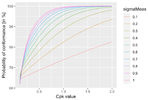Semoi
Involved In Discussions
Hi,
in this forum I found a reference to Wheeler's publication "How to establish Manufacturing Specifications". He publishes a series in which he discusses the following measurement model:
yMeas = yTrue + epsilon,
where
yTrue~N(mean=0, sd=1)
is the true (but unknown) value,
epsilon~N(0, sigma_e)
is a random measurement error and yMeas is the result of the measurement. What is special about this series is that he "assumes" that yMeas and yTrue are correlated. Thus, even if we measure a value yMeas, which is on the specification boundary, we can be pretty sure that the true value yTrue is within the specification. The graph looks as follows:

The key to understand this behaviour is that the mean value of yTrue is well within the specification. Therefore, if we obtain a measurement on (or close to) the specification boundary, we have a high probably that this is merely a measurement error -- in particular, if the Cpk is above 1.
Wheeler concludes that if the production process is in statistical control, the standard (AIAG, Minitab etc.) requirements for the measurement system are over conservative.
I am working in the medical device manufacturing industry, and I doubt that I will be able to implement Wheeler's logic soon -- our manufacturing processes are not stable enough, yet. However, if you have implemented Wheeler's methods, I am interested in reading how it went. Was it a success, or did you overlook something? Also, if you have not implemented it, I am interested in reading your arguments. Have you relaxed the requirements for the measurement devices?
Thanks!
in this forum I found a reference to Wheeler's publication "How to establish Manufacturing Specifications". He publishes a series in which he discusses the following measurement model:
yMeas = yTrue + epsilon,
where
yTrue~N(mean=0, sd=1)
is the true (but unknown) value,
epsilon~N(0, sigma_e)
is a random measurement error and yMeas is the result of the measurement. What is special about this series is that he "assumes" that yMeas and yTrue are correlated. Thus, even if we measure a value yMeas, which is on the specification boundary, we can be pretty sure that the true value yTrue is within the specification. The graph looks as follows:

The key to understand this behaviour is that the mean value of yTrue is well within the specification. Therefore, if we obtain a measurement on (or close to) the specification boundary, we have a high probably that this is merely a measurement error -- in particular, if the Cpk is above 1.
Wheeler concludes that if the production process is in statistical control, the standard (AIAG, Minitab etc.) requirements for the measurement system are over conservative.
I am working in the medical device manufacturing industry, and I doubt that I will be able to implement Wheeler's logic soon -- our manufacturing processes are not stable enough, yet. However, if you have implemented Wheeler's methods, I am interested in reading how it went. Was it a success, or did you overlook something? Also, if you have not implemented it, I am interested in reading your arguments. Have you relaxed the requirements for the measurement devices?
Thanks!
